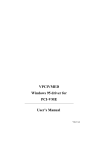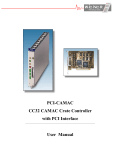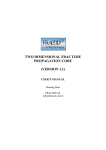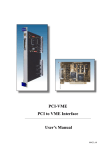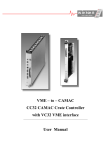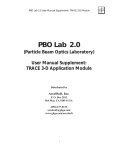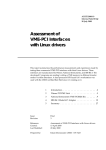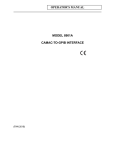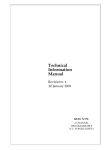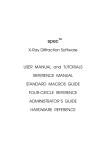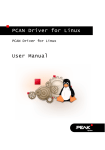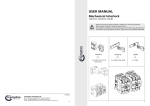Download Vpcic32D.VXD, PCICC32.SYS & PCICC32_NI - W-IE-NE
Transcript
User’s Manual
PCI-CC32
W-Ie–Ne-R
Plein & Baus GmbH
Vpcic32D.VXD,
PCICC32.SYS
&
PCICC32_NI
Windows 95/98 driver, Windows-NT
driver for
PCI-to-CAMAC Interface
User’s Manual
April 2001
1
*00527.A1
User’s Manual
PCI-CC32
W-Ie–Ne-R
Plein & Baus GmbH
General Remarks
The only purpose of this manual is a description of the product. It must not be interpreted a declaration
of conformity for this product including the product and software.
W-Ie-Ne-R revises this product and manual without notice. Differences of the description in manual
and product are possible.
W-Ie-Ne-R excludes completely any liability for loss of profits, loss of business, loss of use or data,
interrupt of business, or for indirect, special incidental, or consequential damages of any kind, even if
W-Ie-Ne-R has been advises of the possibility of such damages arising from any defect or error in this
manual or product.
Any use of the product which may influence health of human beings requires the express written
permission of W-Ie-Ne-R.
Products mentioned in this manual are mentioned for identification purposes only. Product names
appearing in this manual may or may not be registered trademarks or copyrights of their respective
companies.
No part of this product, including the product and the software may be reproduced, transmitted,
transcribed, stored in a retrieval system, or translated into any language in any form by any means with
the express written permission of W-Ie-Ne-R.
VPCICC32D is designed by ARW Elektronik, Germany
Kommentar [vH1]: Versionen
dieses Dokuments:
Wann
... [1]
Windows95/98 und Windows-NT are trade marks of Microsoft Corp.
LINUX is a Linus Torvalds trade mark
April 2001
2
*00527.A1
User’s Manual
PCI-CC32
W-Ie–Ne-R
Plein & Baus GmbH
Table of contents
1. GENERAL DESCRIPTION ........................................................................................................................................4
2. INSTALLATION OF THE WIN95/98 DRIVER.......................................................................................................5
3. INSTALLATION OF THE WIN-NT DRIVER .........................................................................................................7
4. TEST OF DRIVER INSTALLATION........................................................................................................................9
5. DRIVER DESCRIPTION ..........................................................................................................................................10
5.1. LOAD DRIVER ........................................................................................................................................................10
5.2. DRIVER ACCESS .....................................................................................................................................................11
5.3. READ AND WRITE ..................................................................................................................................................12
5.4. CALCULATION OF ACCESS ADDRESS FROM NAF-CODE ...........................................................................................13
5.5. CLOSE DRIVER .......................................................................................................................................................13
6. VPCIC32D AND PCICC32 SERVICES...................................................................................................................14
6.1. ATTACH WINDOW - VPCIC32_ATTACH_CC32 [0X00220000] .........................................................................14
6.2. DETACH WINDOW - VPCIC32_DETACH_CC32 [0X00220004] .........................................................................14
6.3. GET STATUS - VPCIC32_GET_STATUS OR PCICC32_GET_STATUS [0X00220008] ....................................14
6.4. CLEAR STATUS - VPCIC32_CLEAR_STATUS OR PCICC32_CLEAR_STATUS [0X0022000C]......................15
6.5. SETACCESSPARAMETER - VPCIC32_SET_ACCESS_PARA OR PCICC32_SET_... [0X00220010] ...................15
6.6. CONTROLINTERRUPTS – VPCIC32_CONTROL_INTERRUPTS OR PCICC32_CONTROL... ............................16
6.7. IRQHANDLER – VPCIVME_INSTALL_IRQ_HANDLER [0X00220018]...........................................................16
6.8. IRQRESPONSE – PCICC32_INSTALL_IRQ_BLOCK [0X0022001C] .................................................................17
6.9 ACCESS LCR – VPCIC32_ACCESS_LCR OR PCICC32_ACCESS_LCR [0X00220020] .....................................17
7. CAMAC LIBRARY PCICC32_NI.DLL ..................................................................................................................19
7.1. INITIALIZE AND CLOSE CALLS ................................................................................................................................19
7.2. CAMAC READ AND WRITE CALLS ........................................................................................................................19
7.3. GENERAL CAMAC COMMANDS ............................................................................................................................21
7.4. LAM OPERATIONS AND CALLS ..............................................................................................................................22
7.5. SOFTWARE INTERFACE ...........................................................................................................................................23
8. LABVIEW-VI’S..........................................................................................................................................................25
9. DRIVER LIMITATIONS ..........................................................................................................................................26
April 2001
3
*00527.A1
User’s Manual
PCI-CC32
W-Ie–Ne-R
Plein & Baus GmbH
1. GENERAL DESCRIPTION
Vpcic32D.VXD provides an easy access to the CC32 CAMAC crate controller for Windows951 and 98
users. The same does PCICC32.SYS for Windows-NT.
A separate driver is provided for use with LINUX2. The properties of this driver are not explained here.
It is easy to use the drivers for your own CAMAC application. The driver is independent from the
chosen programming language since WIN32 standard I/O functions are used for communication to the
drivers.
There are small differences in the application interface. These differences are mentioned when
appropriate (noted WIN95/98 or WIN-NT)
WIN95/98: CAMAC access is performed via an interface window of an area of virtual memory, which
is defined by the driver. For user applications this window looks like normal memory. Read and write
operations to the CAMAC controller and / or bus are converted into simple read and write operations
whereas the destination (address) corresponds to the NAF code of the operation.
WIN-NT: CAMAC access is performed with normal file read and write operations. A “file offset”
calculated from the NAF code is used to reference the access location. Since a file read/write does not
know if the element to read or write should be 16-bit or 32-bit in size, this property has to be set before
the read/write operation. This setup is done with a special I/O-call to the driver.
The access to the drivers are not limited to one process. Multiple processes can use the drivers. Even
one driver supports multiple CAMAC interfaces.
Two different hardware interrupts (LAM and time out) are handled by the interface. The driver
provides several services to operate these interrupts.
1
Windows95 and Windows98 are trademarks of the Microsoft Corporation.
2
LINUX is a trademark of Linus Torvalds.
April 2001
4
*00527.A1
User’s Manual
PCI-CC32
W-Ie–Ne-R
Plein & Baus GmbH
2. INSTALLATION OF THE WIN95/98 DRIVER
The PCI-CAMAC system consisting of PCIADA and CC32 has been delivered with software drivers
and applications on a CD-ROM. This CD-ROM includes in the PCICAMAC directory the following
files:
Subdirectory \WIN95\DRIVER:
Vpcic32D.vxd
pciC32.inf
-
Win95/98 driver
‘INF’ file for installation
-
driver interface header-file for applications,
vpcic32d.vxd driver source
Subdirectory \WIN95\DRIVER\SOURCE:
Vpcic32D.h
Note: The driver only works with Windows 95 / 98 in 32 bit mode including console applications.
Only real 32 bit applications can use the driver. It does not work with MS-DOS2 or
WINDOWS 3.11 programs.
Note: Windows NT systems require a different driver however, the driver interface will be partially
compatible.
Be sure that PCIADA card of the PCI-CAMAC system is installed in your PC. Please refer to the PCICAMAC user manual to insert the card.
After switching on the computer the MS-Windows operating system recognizes automatically the new
hardware in your system and asks for the driver and “INF“ file. Insert the supplied CD into your CDROM drive and enter the driver’s path. If your CD-ROM drive is the “D:drive“ type:
D:\ PCICAMAC\WIN95\DRIVER\
In the following installation process the driver is copied to the Windows system directory
“WINDOWS\SYSTEM\Vpcic32D.VXD“ and the interface is entered into the Windows Registry
(under HKEY_LOCAL_MACHINE\ENUM\PCI\VEN10B5&DEV2258....).
To check the driver installation and settings you will find the interface at the systems settings of the
control panel (start / settings / control panel / system / device manager) where interrupt and I/O settings
can be verified.
2
April 2001
MS-DOS and Windows 3.11 are trademarks of the Microsoft Corporation.
5
*00527.A1
User’s Manual
PCI-CC32
W-Ie–Ne-R
Plein & Baus GmbH
Picture 1. Example of settings / control panel / system / device manager
Note:
The PCIADA interface card can work with both VME (VMEMM) and CAMAC (CC32)
systems. Normally the PCIADA is configured for use with CC32. If you have to change the
PCIADA configuration for any reason please look for the description of the program
PLXeep.exe.
April 2001
6
*00527.A1
User’s Manual
PCI-CC32
W-Ie–Ne-R
Plein & Baus GmbH
3. INSTALLATION OF THE WIN-NT DRIVER
The PCI-CAMAC system consisting of PCIADA and CC32 has been delivered with software drivers
and applications on a CD-ROM. This CD-ROM includes in the PCICAMAC directory the following
files:
Subdirectory \WINNT\DRIVER:
Pcicc32.sys
install.exe
-
Windows-NT kernel driver
installation program to install and start the driver
-
driver interface header-file for applications,
pcicc32.sys driver source
Subdirectory \WINNT\DRIVER\SOURCE:
Pcicc32.h
Note: The driver only works with Windows-NT including console applications running on
Windows-NT.
Note: Windows-95/98 systems require a different driver however, the driver interface will be partially
compatible.
Be sure that PCIADA card of the PCI-CAMAC system is installed in your PC. Please refer to the PCICAMAC user manual to insert the card.
Now start your computer running Windows-NT and login as administrator. Open a dos box and change
to the CDROM-path with the driver and the install program. Then call the install program with
following parameters. If your CD-ROM drive is the “D:drive“ type:
D:
cd \ PCICAMAC\WINNT\DRIVER
install –d=pcicc32.sys –v
In the following installation process the driver is copied to the Windows driver directory
“WINNT\SYSTEM32\DRIVERS\pcicc32.sys“ and some information is added to the registry. The
driver is started immediately.
To check the driver installation and settings you will find the interface at the systems settings/devices
with the entry “PCICC32 started automatic”.
April 2001
7
*00527.A1
User’s Manual
PCI-CC32
W-Ie–Ne-R
Plein & Baus GmbH
Picture 2. Example of System Settings / Devices
Note:
You can remove the driver with the install program too. Please invoke “install -?” for more
information.
Note:
The PCIADA interface card can work with both VME (VMEMM) and CAMAC (CC32)
systems. Normally the PCIADA is configured for use with CC32. If you have to change the
PCIADA configuration for any reason please look for the description of the program
PLXeep.exe.
April 2001
8
*00527.A1
User’s Manual
PCI-CC32
W-Ie–Ne-R
Plein & Baus GmbH
4. TEST OF DRIVER INSTALLATION
To test the correct driver installation as well as the hardware operation there is the program
“pcicc32_test.exe“ which can be found on the on the driver and application CD-ROM. To avoid
interference with any other CAMAC hardware please use the program first with only the CC32 inserted
into the CAMAC crate.
To run the program use either the “RUN” option of the Windows START menu or open the MS-DOS
box and start the application with “pcic32_test.exe“ after setting the path to the directory on the CDROM containing it. . The program can be started with different run-time parameters; the call
“pcic32_test -?“ prints a short help text including the parameter list.
If working correctly the pcic32_test.exe program performs for about 20 seconds multiple accesses to
all CAMAC station numbers (N) with all possible sub-addresses (A) and function codes (F).
Note: The default driver path for WIN95/98 is “\\.\C:\WINDOWS\SYSTEM\Vpcic32D.vxd”. If using
a different path this has to be considered in the run-time parameters calling pcic32_test.exe.
Note: The default driver path for WIN-NT is “\\.\PCICC32:\CC32_1”. The “.._1” pinpoints the CC32
interface configured for module number 1. For further information about the module number
see the PCICC32 hardware users manual.
April 2001
9
*00527.A1
User’s Manual
PCI-CC32
W-Ie–Ne-R
Plein & Baus GmbH
5. DRIVER DESCRIPTION
WIN95/98: The “Vpcic32D.vxd“ is a dynamically loadable Driver, i.e. it will not be implemented
during the start of the operating system. Every application using the driver has to load it first and has to
release it before closing. Up to 16 PCI interface cards (PCIADA) corresponding up to 16 CAMAC
controllers (CC32) can be accessed via the driver. They all are distinguished only by the different CC32
module number.
WIN-NT: The driver is loaded during the start of WINDOWS-NT. Every application using the driver
has to create a path to the device first and removes it when closing. Up to 16 PCI interface cards
(PCIADA) corresponding up to 16 CAMAC controllers (CC32) can be accessed via the driver. They all
are distinguished only by a different CC32 path number, e.g. PCICC32:\CC32_1, PCICC32:\CC32_2,
...
The VpciC32D driver establishes a well defined software interface to the PCI-CAMAC hardware. It
works in the processor ring-0 (WIN95/98) or as kernel driver (WIN-NT) and is available to all calling
applications with equal rights. Thus it can be used simultaneously by multiple applications however, it
does not support asynchronous calls.
Access to the driver is managed by Windows Standard I/O functions which are independent from the
programming language. Header files for c++ programs are supplied with the interface. They can be
easily adapted to other languages.
All driver parameters (addresses) will be taken from the Windows Registry. This simplifies the calls in
the user application.
WIN95/98: For a maximum performance the PCI-to-CAMAC access is done using a 32kB memory
segment for NAF coding and data transfer. User applications can directly read or write to the CAMAC
dataway via this memory segment without further hardware consideration. To do this the application
has to request first the window to the CAMAC address space. The driver returns a pointer to it which
can be used as the base address of the segment. Within the window the relative address corresponds to
the NAF code of the CAMAC call. The windows can be accessed by multiple applications
simultaneously without further restrictions.
WIN-NT: For compatibility with standard file access mechanisms all reads and writes to CAMAC are
done via standard file-read and file-write calls. A special IO-control call is used to setup the data access
width for further reads or writes. With the standard “ SetFilePointer(...)” call the next access address
calculated from the NAF-code is set.
No auto-increment or decrement of access addresses is
supported.
5.1. Load Driver
hHandle = CreateFile(PathName,0,0,NULL,0,
April 2001
10
*00527.A1
User’s Manual
PCI-CC32
W-Ie–Ne-R
Plein & Baus GmbH
FILE_FLAG_DELETE_ON_CLOSE,NULL);
During this procedure number and IDs of connected CC32 CAMAC controllers is determined.
Note: The pathname differs for WIN95/98 and WIN-NT. The WIN-NT pathname carries the module
number to access while the WIN95/98 path opens a more general path to all available CC32 interfaces
connected to this computer. This implies for WIN-NT that the “dwInterface” variable used with the
input structure of the DevciceIoControl(...) calls is only a idle placeholder. With the WIN95/98
application interface this “dwInterface” variable selects the called CC32 module number.
5.2. Driver access
The driver provides different services which can be called from a user application via the Windows
function DeviceIoControl():
result = DeviceIoControl(
hHandle,
service,
&input,
sizeof(input),
&output
sizeof(output),
&DIOC_count,
NULL);
handle to CC32
service code called
reference to input structure
size of input structure
reference to output structure
size of output structure
reference of real size of returned data
The first parameter hHandle indicates a particular CC32 controller, i.e. the driver itself considers the
connection between the CC32 with given CC32 module number and the corresponding PCIADA
interface card.
The second parameters describes the service to be called. This can be done by using the pre-defined
service names or the corresponding numbers (see Vpcic32d.h for WIN95/98 or pcicc32.h for WIN-NT)
as for instance VPCIC32_ATTACH_CC32 defined with 0x00220000. In addition each service is
associated with a particular input and output structure. This requires the definition of pointers to the
structures as well as to their sizes as shown in the following example.
The call of “DeviceIOControl(..)“ returns a result value which indicates in case of “0” the correct
operation. If an error occurred the value is different to 0. In this case the Windows function
“GetLastError()“ will return the error number. All error numbers are defined in the “winerror.h“ header
file.
WIN95/98: Example for requesting a memory window into the CC32 address space
VPCIC32D_DEVICE
VPCIC32D_WINDOW
DWORD
DWORD
April 2001
sInterface;
sWindow;
DIOC_count;
dwResult;
11
*00527.A1
User’s Manual
PCI-CC32
W-Ie–Ne-R
Plein & Baus GmbH
*
*
sInterface.dwInterface = 1;
// selection of CC32 with Module #1
// request for a memory window into CAMAC CC32 -----------------dwResult = DeviceIoControl(hHandle, VPCIC32_ATTACH_CC32,
&sInterface, sizeof(sInterface), &sWindow, sizeof(sWindow),
&DIOC_count, NULL);
if (!dwResult)
printf(„Error %d occured\n“, GetLastError());
else
printf(„I have got a memory window @ 0x%08x\n“, sWindow.pvWindowBase);
*
*
The called service is “VPCIC32_ATTACH_CC32“ with a single DWORD input structure sInterface
containing the CC32 number. The size of this input structure is “sizeof(sInterface)“.
The call returns the structure “VPCIC32D_WINDOW sWindow“ with size “sizeof(sWindow)“ which
contains the base address for the CC32 window.
The variable „DIOC_count“ contains the real size of the returned data from the driver
5.3. Read and Write
This applies only to WIN-NT, with WIN95/98 all reads and writes are done via a direct accessible 32
kbyte memory segment.
First you have to set the file pointer to the address location calculated from the NAF-code. If the
address pointer still is set nothing is to do. Then you can read or write a block of data which size is a
multiple of the preset data access width (2 or 4 bytes).
DWORD ReadCAMAC(HANDLE hHandle,
unsigned long adr,
void *buffer,
int nBytesToRead)
{
DWORD bytesRead;
SetFilePointer(hHandle, adr, NULL, FILE_BEGIN);
April 2001
12
*00527.A1
User’s Manual
PCI-CC32
W-Ie–Ne-R
Plein & Baus GmbH
if (!ReadFile(hHandle, buffer, nBytesToRead, &bytesRead, NULL))
printf("Can't read (0x%08x)\n", GetLastError());
return bytesRead;
}
Note:
To improve performance you can open a path to each block-read or block-write NAF-codes,
even if they are accessed through the same CC32 interface. Then you have to set the file
pointer only once at initial setup of the path.
5.4. calculation of access address from NAF-code
According to the PCICC32 hardware manual the access address is calculated like
#define NAF(n, a, f) ((unsigned long)((n << 10) + (a << 6) + ((f & 0xf) << 2)))
It is advisable to use this macro for all calculations.
5.5. Close driver
After using the driver it has to be closed before finishing the application:
CloseHandle(hHandle);
The driver will be automatically removed from the system when closed by the last application
previously using it.
April 2001
13
*00527.A1
User’s Manual
PCI-CC32
W-Ie–Ne-R
Plein & Baus GmbH
6. VPCIC32D AND PCICC32 SERVICES
Please see for reference the “vpcic32d.h“ header file (WIN95/98) or the “pcicc32.h” header file (WINNT).
6.1. Attach Window - VPCIC32_ATTACH_CC32 [0x00220000]
This call is not applicable to WIN-NT.
VPCIC32_ATTACH_CC32 generates a memory window into the CC32 CAMAC address space.
Input structure:
Output structure:
typedef struct
{
DWORD dwInterface;
} VPCIC32D_DEVICE;
typedef struct
{
DWORD dwInterface;
void *pvWindowBase;
} VPCIC32D_WINDOW;
// CC32 module number
// CC32 module number
// the base address into the 32 kbyte Window
6.2. Detach Window - VPCIC32_DETACH_CC32 [0x00220004]
This call is not applicable to WIN-NT.
VPCIC32_DETACH_CC32 deinitializes the PCIADA with the corresponding CC32 controller. The
CAMAC windows is released.
Input structure:
Output structure:
typedef struct
{
DWORD dwInterface;
} VPCIC32D_DEVICE;
// CC32 module number
There is nothing to output. Pointer to structure is NULL, size of structure is 0.
6.3. Get Status - VPCIC32_GET_STATUS or PCICC32_GET_STATUS [0x00220008]
VPCIC32_GET_STATUS (WIN95/98) or PCICC32_GET_STATUS (WIN-NT) allows to obtain the
status of the PCIADA interface card (time-out) as well as of the CC32 crate controller (LAM). This call
can be used for LAM polling.
April 2001
14
*00527.A1
User’s Manual
PCI-CC32
W-Ie–Ne-R
Plein & Baus GmbH
Input structure:
Output structure:
typedef struct
{
DWORD dwInterface;
} VPCIC32D_DEVICE;
// CC32 module number, idle for WIN-NT
typedef struct
{
DWORD dwInterface;
// CC32 module number, idle for WIN-NT
WORD bTimeout;
// PCIADA timeout
WORD bInterrupt;
// pending LAM interrupt of CC32
} VPCIC32D_DEVICE; // (WIN95/98), PCICC32_DEVICE (WIN-NT)
The returned bTimeout indicates a hardware error or disconnection of the CC32 controller (or CAMAC
power off). The output bLAM shows any active pending LAM-interrupt (Look At Me).
Note: The LAM interrupt depends in addition to a LAM request from a CAMAC station on the
LAM mask setting of the controller. Please see the PCI-CAMAC manual for reference.
6.4. Clear Status - VPCIC32_CLEAR_STATUS or PCICC32_CLEAR_STATUS [0x0022000C]
VPCIC32_CLEAR_STATUS (WIN95/98) or PCICC32_CLEAR_STATUS (WIN-NT) can be used to
clear a pending bTimeout interrupt. The pending bLam has to be cleared at the appropriate CAMAC
slave station with corresponding calls from the user.
Input structure:
typedef struct
{
DWORD dwInterface;
// CC32 module number, idle for WIN-NT
} VPCIC32D_DEVICE; //(WIN95/98), PCICC32_DEVICE (WIN-NT)
Output structure: There is nothing to output. Pointer to structure is NULL, size of structure is 0.
6.5. SetAccessParameter - VPCIC32_SET_ACCESS_PARA or PCICC32_SET_... [0x00220010]
PCICC32_SET_ACCESS_PARA allows to set the further data access width for this path to 16-bit or 2
byte or 32-bit or 4 byte. With the wBlockTransfer parameter you can enable or disable some features
for fast data readout. The UNTIL_NOT_Q enables the next read into the provided buffer until not ‘Q’
is signaled from the slave device or the buffer is filled. AUTOREAD enables the PCIADA to read one
item ahead to increase readout speed through overlapp of PC-read and CAMAC-read.
Please note that the parameter “wAccessType” at WIN95/98 is determined with the access itself. Also
the UNTIL_NOT_Q has no function at WIN95/98. Due to the direct access mechanism the access code
has to manage this feature itself.
April 2001
15
*00527.A1
User’s Manual
PCI-CC32
W-Ie–Ne-R
Plein & Baus GmbH
Input structure:
typedef struct
{
ULONG dwInterface;
//
USHORT wAccessType; // set the current access type, see “pcicc32.h” (idle @ WIN95)
USHORT wBlockTransfer; // see table
} PCICC32_ACCESS_COMMAND;
wBlockTransfer
UNTIL_NOT_Q
AUTOREAD
read until not Q
only applicable for WINNT
PCIADA reads 1 item ahead
Table: wBlockTransfer modes
Output structure:
There is nothing to output. Pointer to structure is NULL, size of structure is 0.
6.6. ControlInterrupts – VPCIC32_CONTROL_INTERRUPTS or PCICC32_CONTROL...
VPCIC32_CONTROL_INTERRUPTS (WIN95/98) or PCICC32_CONTROL_INTERRUPTS (WINNT) enables or disables interrupt requests for this path. Note that interrupt requests are associated to a
CC32 module and not to a special path. This implies that only one of the paths accessing a special
CC32 module can provide interrupt handling for this module.
Input structure:
typedef struct
{
DWORD dwInterface;
// CC32 module number, idle for WIN-NT
WORD wEnable;
// a 1 enables, a 0 disables interrupt requests
} VPCIC32D_IRQ_CONTROL; // (WIN95/98), PCICC32_IRQ_CONTROL
Output structure: There is nothing to output. Pointer to structure is NULL, size of structure is 0.
6.7. IRQHandler – VPCIVME_INSTALL_IRQ_HANDLER [0x00220018]
This is not applicable to WIN-NT.
VPCIC32_INSTALL_IRQ_HANDLER install a callback routine to a CC32 module. This function is
called whenever interrupts are enabled and the handler is installed. To prevent interrupt overflows the
driver itself clears the LAM-Flip-Flop or resets the PCIADA depending on the interrupt source.
Input structure:
typedef struct
{
DWORD dwInterface;
// CC32 module number, idle for WIN-NT
DWORD dwIrqHandler; // void (*IrqHandler)(DWORD),User Handler
} VPCIC32D_IRQ_HANDLER;
April 2001
16
*00527.A1
User’s Manual
PCI-CC32
W-Ie–Ne-R
Plein & Baus GmbH
Output structure: There is nothing to output. Pointer to structure is NULL, size of structure is 0.
When called the IRQ-handler callback function is called with the current LAM-vector as argument. For
all possible LAM-vectors see 6.8.
6.8. IRQResponse – PCICC32_INSTALL_IRQ_BLOCK [0x0022001C]
This is not applicable to WIN95/98.
PCICC32_INSTALL_IRQ_BLOCK installs a blocking IO-Control call which waits for a interrupt to
occur. The call returns only if a interrupt has raised and the interrupt is enabled. It returns immediately
without error when a interrupt was pending. To prevent interrupt overflows you have to re-enable
interrupts when the call returns without error. No input structure is needed, the output structure
provides information about what interrupts ceased the blocking.
Input structure:
There is nothing to input. Pointer to structure is NULL, size of structure is 0.
Output structure:
typedef struct
{
DWORD dwInterface;
// CC32 module number
DWORD dwInterruptFlags; // flags to mark pending interrupts
} PCICC32_IRQ_RESPONSE;
The “dwInterruptFlags” correspond to the LAM-AND Status of the CC32 associated to this path.
Bit #
0
1
*
*
23
24
25
26
27
28
29
30
31
Function
LAM0 AND LAM_MASK0
LAM1 AND LAM_MASK1
*
*
LAM23 AND LAM_MASK23
0
0
0
bTimeout
LAM-BUS-OR
LAM-NOT-OR
LAM-AND-OR
LAM-Flip-Flop
The PCIADA-timeout interrupt flag “bTimeout” is mapped into bit #27 of “dwInterruptFlags”.
6.9 Access LCR – VPCIC32_ACCESS_LCR or PCICC32_ACCESS_LCR [0x00220020]
April 2001
17
*00527.A1
User’s Manual
PCI-CC32
W-Ie–Ne-R
Plein & Baus GmbH
VPCIC32_ACCESS_LCR or PCICC32_ACCESS provides a way to access the Local Configuration
Registers LCR of the PLX chip hosted on PCIADA. This feature is for test and debug only.
typedef struct
{
ULONG dwInterface;
// here dummy 'cause of compatibility to WIN95
ULONG dwContent;
// content to write, and, or
USHORT wRegisterAddress; // address offset of LCR register
UCHAR bAccessMode;
// LCR_READ, write, or, and
UCHAR bBytesLane;
// the data access width
} PCICC32_LCR_ACCESS;
// data lane size constants for PCICC32_ACCESS_LCR
#define BYTE_ACCESS (UCHAR)1 // write byte wise (illegal)
#define WORD_ACCESS (UCHAR)2 //
word
#define LONG_ACCESS (UCHAR)4 //
long
// PCICC32_ACCESS_LCR access constants
#define LCR_READ
0
// read only access
#define LCR_WRITE 1
// write and read back access
#define LCR_OR
2
// read, bitwise 'or' content and read back access
#define LCR_AND
3
// read, bitwise 'and' content and read back access
#define LCR_WRITE_ONLY 4
// do not read back after write
With the bAccessMode constant you can define the type of access. Even a atomic OR or AND of the
content with the given register is possible.
Please note that using this feature in parallel to normal use of the driver can make the driver and even
the operating system unstable.
April 2001
18
*00527.A1
User’s Manual
PCI-CC32
W-Ie–Ne-R
Plein & Baus GmbH
7. CAMAC LIBRARY PCICC32_NI.DLL
The “pcicc32_ni.dll“ adds a user friendly CAMAC library to the PCI-CAMAC driver. This layer
standardizes the CAMAC calls for the different operating systems Windows 95/98, Windows NT and
LINUX allowing to port application programs between these operating systems with minimum
changes.
The following paragraph describes the CC32 / PCIADA CAMAC calls based on the use of the
pcicc32_ni.dll and pcicc32_ni.lib Library. Please refer to the CC32 manual and the driver description in
this manual.
The PCICC32dem.C file supplied on the driver and application CD-ROM shows examples for the use
of this library. Please note the different device driver path declarations for use within Windows 95/98
and Windows NT and LINUX.
7.1. Initialize and Close calls
cc32_open (cszPath, nModuleNumber, *handle);
char *cszPath
path to driver or device, depends on OS
int nModuleNumber
number of CC32 (default 1)
CC32_HANDLE *handle
handle to path
cc32_close (handle);
CC32_HANDLE handle
handle to path
7.2. CAMAC Read and Write calls
Read 16 bits with N,A,F
cc32_read_word (handle, N, A, F);
CC32_HANDLE handle
unsigned int N
unsigned int A
unsigned int F
return: unsigned short data
handle to path
CAMAC station N
CAMAC sub-address A
CAMAC function F
16 bit data (D15..D00 = R16..R1)
Read 32 bits with N,A,F and get the result Q and X
cc32_read_long (handle, N, A, F, Q, X);
CC32_HANDLE handle
handle to path
unsigned int N
CAMAC station N
April 2001
19
*00527.A1
User’s Manual
PCI-CC32
W-Ie–Ne-R
Plein & Baus GmbH
unsigned int A
unsigned int F
char *Q
char *X
return: unsigned long data
CAMAC sub-address A
CAMAC function F
Q response
X response
32 bit data (D23..D00 = R24..R1, D29..D24 = 0,
D31,D30 Q,X )
Read 32 bits with N,A,F
cc32_read_long_all (handle, N, A, F);
CC32_HANDLE handle
unsigned int N
unsigned int A
unsigned int F
return: unsigned long data
handle to path
CAMAC station N
CAMAC sub-address A
CAMAC function F
32 bit data (D23..D00 = R24..R1, D29..D24 = 0,
D31,D30 Q,X )
Write 16 bits with N,A,F
cc32_write_word (handle, N, A, F, uwData);
CC32_HANDLE handle
unsigned int N
unsigned int A
unsigned int F
unsigned short data
handle to path
CAMAC station N
CAMAC sub-address A
CAMAC function F
16 bit data (D15..D00 = W16..W1)
Write 32 bits with N,A,F
cc32_write_long (handle, N, A, F, ulData);
CC32_HANDLE handle
unsigned int N
unsigned int A
unsigned int F
unsigned long data
handle to path
CAMAC station N
CAMAC sub-address A
CAMAC function F
32 bit data (D15..D00 = W16..W1)
Read 16 bit data into a buffer with N,A,F
cc32_read_word_buffer(handle, N, A, F, pwBuffer, pdwLen)
CC32_HANDLE handle
handle to path
unsigned int N
CAMAC station N
unsigned int A
CAMAC sub-address A
unsigned int F
CAMAC function F
unsigned long *pwBuffer
pointer to a word (16 bit) buffer
April 2001
20
*00527.A1
User’s Manual
PCI-CC32
W-Ie–Ne-R
Plein & Baus GmbH
unsigned long *pdwLen
Read 32 bit data into a buffer with N,A,F
pointer to the length of the buffer in words
cc32_read_long_buffer(handle, N, A, F, pdwBuffer, pdwLen)
CC32_HANDLE handle
handle to path
unsigned int N
CAMAC station N
unsigned int A
CAMAC sub-address A
unsigned int F
CAMAC function F
unsigned long *pdwBuffer pointer to a long (32 bit) buffer
unsigned long *pdwLen
pointer to the length of the buffer in longs
Read 32 bit data into a buffer with N,A,F without any masking of X, Q information
cc32_read_long_all_buffer(handle, N, A, F, pdwBuffer, pdwLen)
CC32_HANDLE handle
handle to path
unsigned int N
CAMAC station N
unsigned int A
CAMAC sub-address A
unsigned int F
CAMAC function F
unsigned long *pdwBuffer pointer to a long (32 bit) buffer
unsigned long *pdwLen
pointer to the length of the buffer in longs
Set the access features for the next transfers
cc32_access_switch (handle, unsigned short wSwitch)
CC32_HANDLE handle
handle to path
unsigned short wSwitch
Constants SW_UNTIL_NOT_Q
or SW_AUTOREAD (see driver manual)
7.3. General CAMAC commands
All CC32 commands are based on NAF mapping. System commands (as CAMAC C, Z, I, …) and
LAM mask / broadcast are using station numbers (N) higher than 24. Please see the CC32 hardware
manual for reference.
N0*A0*Fx
N0*A1*Fx
= C (Camac Clear)
= Z (Camac Initialize)
(Write Word)
(Write Word)
N0*A2*Fx
= C + Inhibit reset
(Write Word)
N0*A3*Fx
= Z + Inhibit set
(Write Word)
= Inhibit set
= Inhibit reset
(Write Word)
(Write Word)
N27*A0*Fx
N27*A1*Fx
April 2001
21
*00527.A1
User’s Manual
PCI-CC32
W-Ie–Ne-R
Plein & Baus GmbH
Examples:
CAMAC-C
CAMAC-Z
Set Inhibit
Reset Inhibit
cc32_write_word (handle, 0, 0, 16, 0);
cc32_write_word (handle, 0, 1, 16, 0);
cc32_write_word (handle, 27, 0, 16, 0);
cc32_write_word (handle, 27, 1, 16, 0);
7.4. LAM Operations and Calls
N28*A0*Fx = LAM-FF reset
(Write / Read Word)
N28*A1*Fx = LAM-mask
(Write /Read Long )
With:
D23..D00 << MASK24..LMASK1
D27..D24 = 0, D28 = LAM-BUS-OR,
D29 = LAM-NOT-OR, D30 = LAM-AND-OR, D31 = LAM-FF)
N28*A2*Fx = LAM AND mask
(Read Long )
With:
D23..D00 << AND24…AND1
D27..D24 = 0, D28 = LAM-BUS-OR,
D29 = LAM-NOT-OR, D30 = LAM-AND-OR, D31 = LAM-FF)
N28*A3*Fx = LAM NOT mask
(Read Long )
With:
D23..D00 << NOT24…NOT1
D27..D24 = 0, D28 = LAM-BUS-OR,
D29 = LAM-NOT-OR, D30 = LAM-AND-OR, D31 = LAM-FF)
N28*A4*Fx = LAM (no mask)
(Read Long )
With:
D23..D00 << LAM24…LAM1
D27..D24 = 0, D28 = LAM-BUS-OR,
D29 = LAM-NOT-OR, D30 = LAM-AND-OR, D31 = LAM-FF)
Any pending LAM of an enabled station is shown in the LAM FF register depending on the LAMmask.
LAM interrupt status:
cc32_poll_error (handle, *nTimeout, *nLam);
CC32_HANDLE handle
handle to driver
char *nTimeout,
time out flag
char *nLam
LAM flag
Examples:
Enable all LAMs
Reset LAM-FF
Poll LAM
April 2001
cc32_write_word (handle, 28, 1, 16, 0xFFFF);
cc32_write_word (handle, 28, 0, 16, 0);
cc32_poll_error (handle, *nTimeout, *nLam);
22
*00527.A1
User’s Manual
PCI-CC32
W-Ie–Ne-R
Plein & Baus GmbH
7.5. Software interface
The interface to the pcicc32_ni.dll is defined in the Libcc32.h header file:
/*--- DEFINES ---------------------------------------------------------------------------*/
#define SW_UNTIL_NOT_Q 1 /* switches for cc32_access_switch( ..., uSwitch);
#define SW_AUTOREAD 2
*/
/* open a path to a device. E.g. "/dev/pcicc32_1" */
int __declspec(dllexport) cc32_open(char *cszPath, int nModuleNumber, CC32_HANDLE *handle);
/* close the opened path */
int __declspec(dllexport) cc32_close(CC32_HANDLE handle);
/* read only a word - 16 bits - from a address made out of N,A,F */
unsigned short __declspec(dllexport) cc32_read_word(CC32_HANDLE handle, unsigned int N,
unsigned int A, unsigned int F);
/* read a long - 32 bits - from a address made out of N,A,F and get the result Q and X */
unsigned long __declspec(dllexport) cc32_read_long(CC32_HANDLE handle, unsigned int N,
unsigned int A, unsigned int F, char *Q, char *X);
/* read a long - 32 bits - without any interpretation */
unsigned long __declspec(dllexport) cc32_read_long_all(CC32_HANDLE handle, unsigned int N,
unsigned int A, unsigned int F);
/* write a word - 16 bits - to a destination made out of N,A,F */
void __declspec(dllexport) cc32_write_word(CC32_HANDLE handle, unsigned int N, unsigned int A,
unsigned int F, unsigned short uwData);
/* write a long - 32 bits - uninterpreted to a destination made out of N,A,F */
void __declspec(dllexport) cc32_write_long(CC32_HANDLE handle, unsigned int N, unsigned int A,
unsigned int F, unsigned long ulData);
/* poll the state of the timeout line and the LAM state. The timeout line is cleared if it was set */
int __declspec(dllexport) cc32_poll_error(CC32_HANDLE handle, char *nTimeout, char *nLam);
/* read 'len' words or 'UNTIL_NOT_Q' from a address made out of N,A,F into a buffer*/
int __declspec(dllexport) cc32_read_word_buffer(CC32_HANDLE handle, unsigned int N, unsigned
int A, unsigned int F, unsigned short *pwBuffer, unsigned long *pdwLen);
/* read 'len' longs or 'UNTIL_NOT_Q' from a address made out of N,A,F into a buffer*/
int __declspec(dllexport) cc32_read_long_buffer(CC32_HANDLE handle, unsigned int N, unsigned
int A, unsigned int F,
unsigned long *pdwBuffer, unsigned long *pdwLen);
/* read 'len' longs or 'UNTIL_NOT_Q' from a address made out of N,A,F into a buffer, no
interpretation */
int __declspec(dllexport) cc32_read_long_all_buffer(CC32_HANDLE handle, unsigned int N,
unsigned int A, unsigned int F, unsigned long *pdwBuffer, unsigned long *pdwLen);
/* switch UNTIL_NOT_Q or AUTOREAD on or off */
int __declspec(dllexport) cc32_access_switch(CC32_HANDLE handle, unsigned short uwSwitch);
April 2001
23
*00527.A1
User’s Manual
PCI-CC32
W-Ie–Ne-R
Plein & Baus GmbH
April 2001
24
*00527.A1
User’s Manual
PCI-CC32
W-Ie–Ne-R
Plein & Baus GmbH
8. LABVIEW-VI’S
Together with the „pcicc32_ni.dll“ the following virtual instruments (VI’s) for the National Instruments
graphical programming software for instrumentation LabView are provided.
c32Init.vi
c32Close.vi
c32PollError.vi
C32ReadLong.vi
C32ReadLongS.vi
C32ReadWord.vi
C32WriteLong.vi
C32WriteWord.vi
c32Test1_95.vi
c32Test1_NT.vi
C32Test2_95.vi
C32Test2_NT.vi
pcicamac.vi
April 2001
the VI to initialize a path to a interface
the VI to close a path opened with c32Init.vi
the VI to get a pending LAM or an interface connection timeout
the VI to read a longword (32 bit) containing X and Q
the same as above but with resolved X and Q
the VI to read a word (16 bit) without reading X and Q
the VI to write a longword (24 bit CAMAC)
the VI to write a word (16 bit) only
a simple write / read test configured for WIN95/98.
the same as above but for WIN-NT
a simple LAM test.
the same as above but configured for WIN-NT.
CAMAC example controller with loop functions and NAF/R/W display.
25
*00527.A1
User’s Manual
PCI-CC32
W-Ie–Ne-R
Plein & Baus GmbH
9. DRIVER LIMITATIONS
• Presently the driver for LINUX does not support hardware interrupt servicing however, all interrupt
sources (time out and LAM) can be monitored by polling the VPCIC32D_GET_STATUS
(WIN95/98) or the PCICC32_GET_STATUS (WIN-NT) function.
• Presently the Labview VI’s for LINUX is not adopted to the shared library for LINUX.
• Presently some of the DLL entries does not have a Labview NI counterpart.
April 2001
26
*00527.A1
Seite 2: [1] Kommentar [vH1]
Dr. Lüder von Horn
Versionen dieses Dokuments:
Wann
Was
Wer
8. Juli 99
Manual erstellt
L. von Horn
19. Juli 99
Änderungen von K. Hitschler berücksichtigt L. von Horn
(vergl. vpcivmed-hitschler.doc)




























